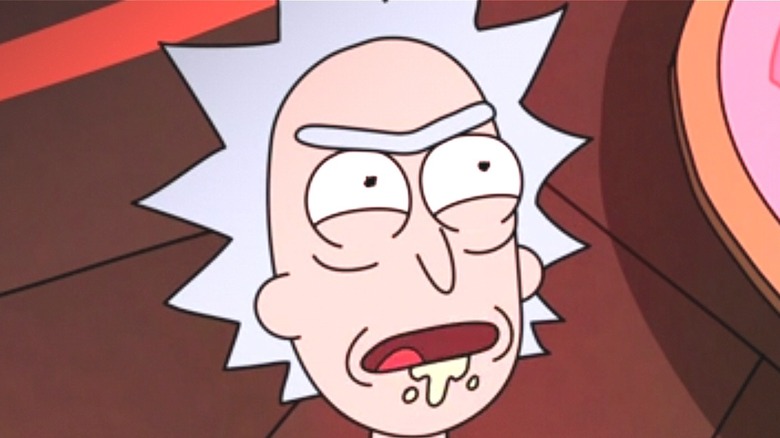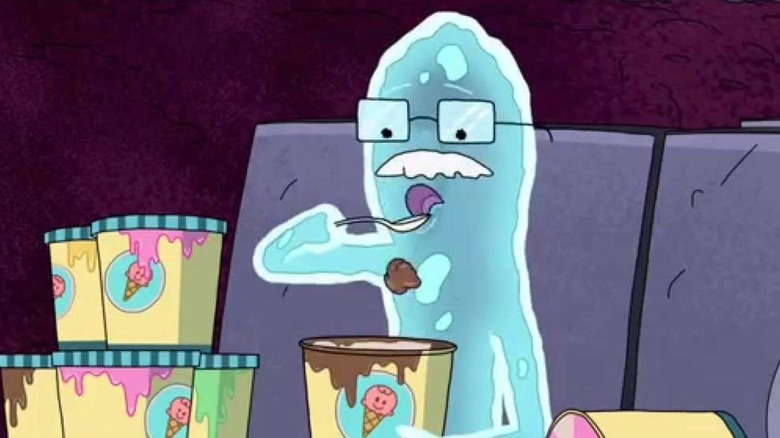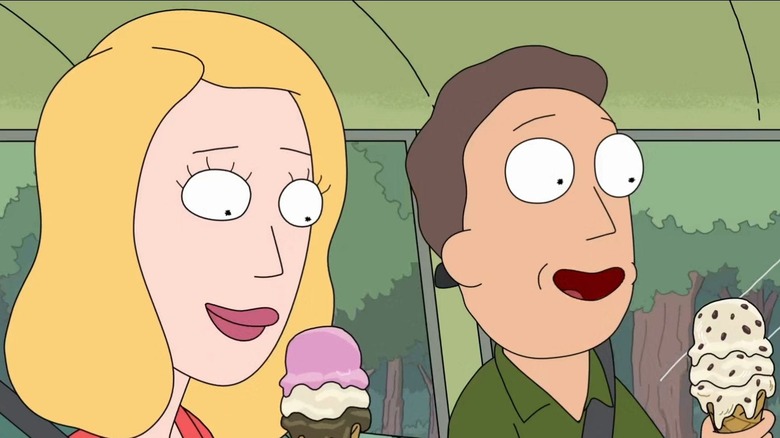The Rick And Morty Ice Cream Theory Explained
"Rick and Morty" has won the hearts of audiences all over the world thanks to its sharp animation, self-aware humor, and philosophical musings that often leave us questioning the very nature of reality. "Rick and Morty" has kept fans thinking and engaged ever since it premiered in 2013. One of the best ways to enjoy Justin Roiland and Dan Harmon's Emmy-winning romp through space and time is to let each episode marinate and dissect the various meanings and theories that it presents.
While the show operates within different sci-fi frameworks and styles each episode, there are recurring plot threads between the Smith and Sanchez family, as well as the various galactic friends and foes Rick shares across different timelines. Each episode continues to expand the infinite timelines and dimensions that exist within the universe, making "Rick and Morty" the perfect show for theorists to discuss.
Each new episode offers new theories to the framework of the show but there's a chance that there's one theory that explains everything, right down to the meaning of life. Yes, there's a "Rick and Morty" theory that connects everything we've seen from the show into a somewhat nice little package, and it all involves ice cream.
The origin of the ice cream theory
Various sci-fi projects have attempted to answer "What's the meaning of life?" While "The Hitchhiker's Guide to the Galaxy" has famously labeled the answer as "42," "Rick and Morty" has suggested on numerous occasions that ice cream is what holds the universe together and makes the world go round.
The theory first gained traction within the fan community when Tumblr user awholecroissant began to ruminate on what connects each episode. Leaning into the meta nature of the series, the user suggested that a thread exists between the use and importance of ice cream throughout the show. Ice cream first showed up in the third episode of the first season, "Anatomy Park." In the episode, Rick sends Morty into the body of his friend, Reuben, to save his life. Inside, Morty discovers that his irreverent grandfather has created a "Jurassic Park"-like theme park inside Reuben's body.
Things naturally go wrong for the colorful cast of characters, and as the body itself faces death, an amoeba inside Reuben, Dr. Xenon Bloom, begins to binge eat ice cream as it's what "true happiness and pleasure" is for him in his final moments. This sets the stage for the rest of the delicious theory.
The meaning of life? Ice cream!
Ice cream continues to pop up throughout the series, including in a key moment in Season 1, Episode 9 "Something Ricked" where Summer and Rick beat up a schoolyard bully who knocks over a child's ice cream cone. This indicates that ice cream is a sacred food in the "Rick and Morty" universe and that robbing someone of enjoying is pretty much a crime. The significance of the cool summer treat pops up through Season 2 and beyond. In the same vein as protecting ice cream, the dessert should also be respected. Season 2, Episode 1 "A Rickle in Time" sees Rick's son-in-law Jerry (a potential reference to ice cream giant Ben and Jerry's?) tipping the fine people at Coldstone Creamery $450 because of their contributions to bringing ice cream to life.
Perhaps the most beautiful moment that adds validity to this theory is during the Season 2 finale, which sees Rick leaving Morty behind to go to the Gloppydrop system to get some ice cream. Why? "If you go to where there's a bunch of ice cream and then you don't come back," Rick says to his young grandson, "you haven't actually gotten ice cream, you've just gone where ice cream is." Essentially, going to where ice cream exists means going someplace safe and worth living, proving that life in the "Rick and Morty" universe just isn't worth it without ice cream.
Ice cream continues to be a recurring thread in Adult Swim's beloved animated series. While the theory isn't as exciting as the ones surrounding Evil Morty or the fact that the characters we know and love change every episode, this theory proves that there's always something sweet and hopeful behind the rough exterior of both Rick and Morty.


